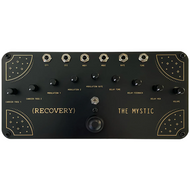The Mystic - Recovery Effects
by Sam Chittenden
Recovery Effects’ new offering, the Mystic, is a small semi-modular, experimental FM synth that encourages exploration with its droning and cross-modulating madness. Physically, the Mystic is a sandwich of three PCBs with open sides and exposed interior that’s attractively done up in black and gold, with nice aesthetic touches such as backlit sections of the top layer’s corners. It features two operators, two modulators and an analog delay section with about a half a second of delay time. There is manual control via mini-pots over both operator oscillators, both modulation oscillators, the modulation rate [the single control influences the rate of both modulators] and over the delay time, feedback, and mix. A final pot is for volume control.
Above the manual knobs there are input jacks offering voltage control over both carrier and modulator frequencies as well as the modulation rate and delay time. The Mystic also has a large momentary switch button for opening and closing an internal VCA as well as a latching switch for drones, and droning is where the Mystic shines. The onboard delay is crunchy and dirty in a great way, and it’s a blast to explore the interplay between the different carrier and modulator relationships. Blurring everything together with a bit of reverb and the Mystic comes alive in interesting and surprising ways. While the Mystic is Eurorack compatible your output will need to be boosted to play well with other modules, as CV in is fine at Eurorack levels but audio out from Mystic is at line level.
If you’re looking for melodic fare, both carriers [at different times depending on the units parameter settings] will respond decently to pitch information, but the normalled cross modulation doesn’t really lend itself to v/oct tracking, not that’s really the point of the Mystic. Think bleepy bloopy noisy madness or crunchy, squealing insect arguments and you’ll be right at the Mystic’s sweetspot. There is some great percussive sample fodder to be found and drenching the output in effects makes for interesting pad-like evolving sound beds and washy background textures. External modulation of the parameters is key and I got the best results when I modulated the hell out everything. Of course, the results are highly dependent on what you are feeding in, but unexpected and intriguing rhythms, timbres, and textures are only a few patch cables away.
I had a lot of fun with the Mystic, but I do wish that there were more onboard paths for feedback patching as the only output is the audio mix out. Having the ability to patch, say, the delay output, or one of the modulators back into the signal path could really open up the possibilities, and ditto if there were any touch points on the unit. It seems to me that those corners with the light up stars are screaming to be interactive. That said, if you like your drones noisy and your synths unpredictable, the Mystic charts a less complex, yet similar path to synths like the Make Noise Strega and SOMA’s Lyra-8. While you definitely need to pair it with other hardware in order to get the most of it, the Mystic lives up to its billing as a fun and engaging, experimental desktop synth.
Price: $279


